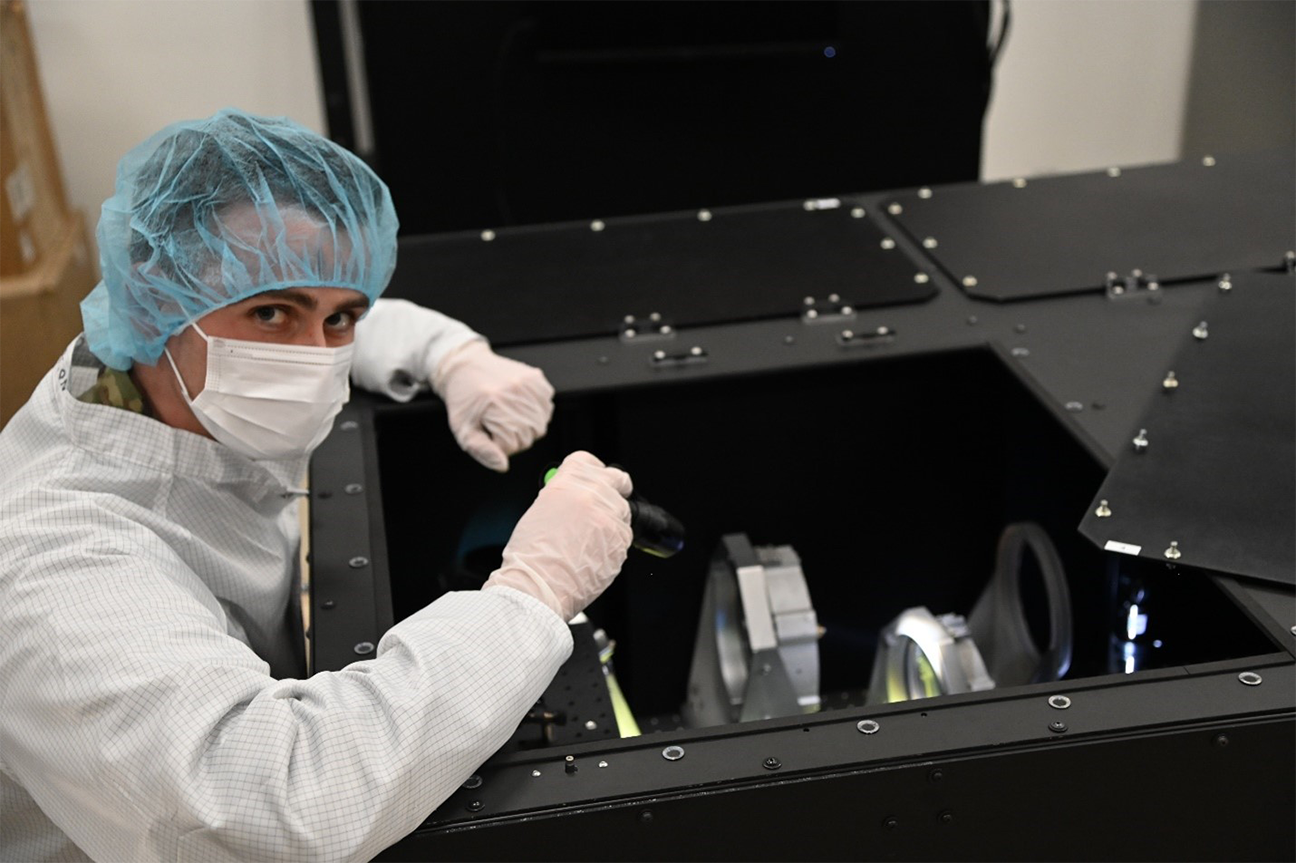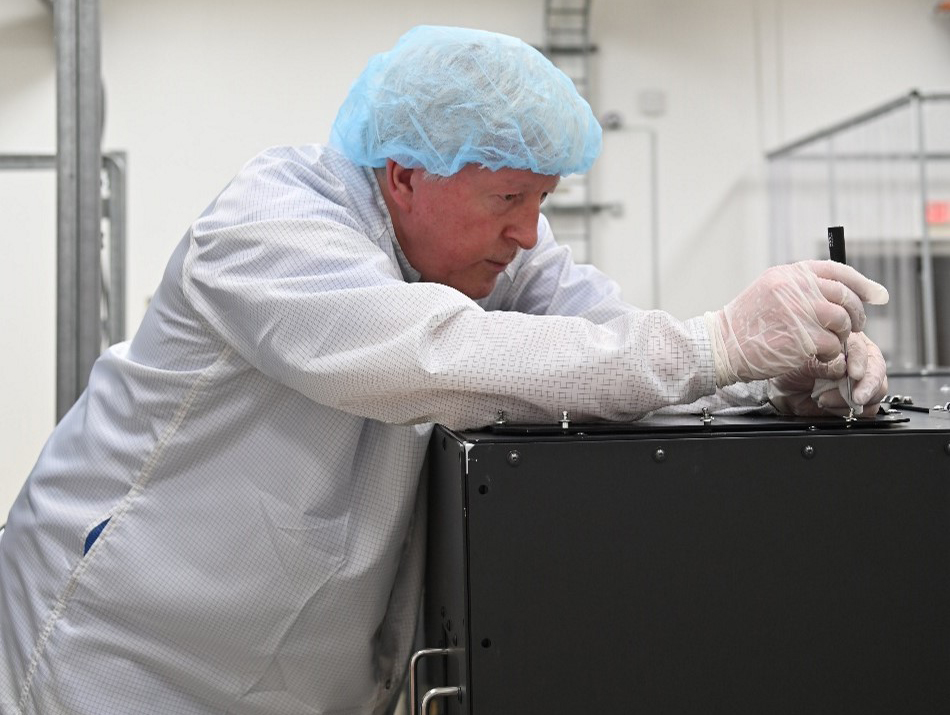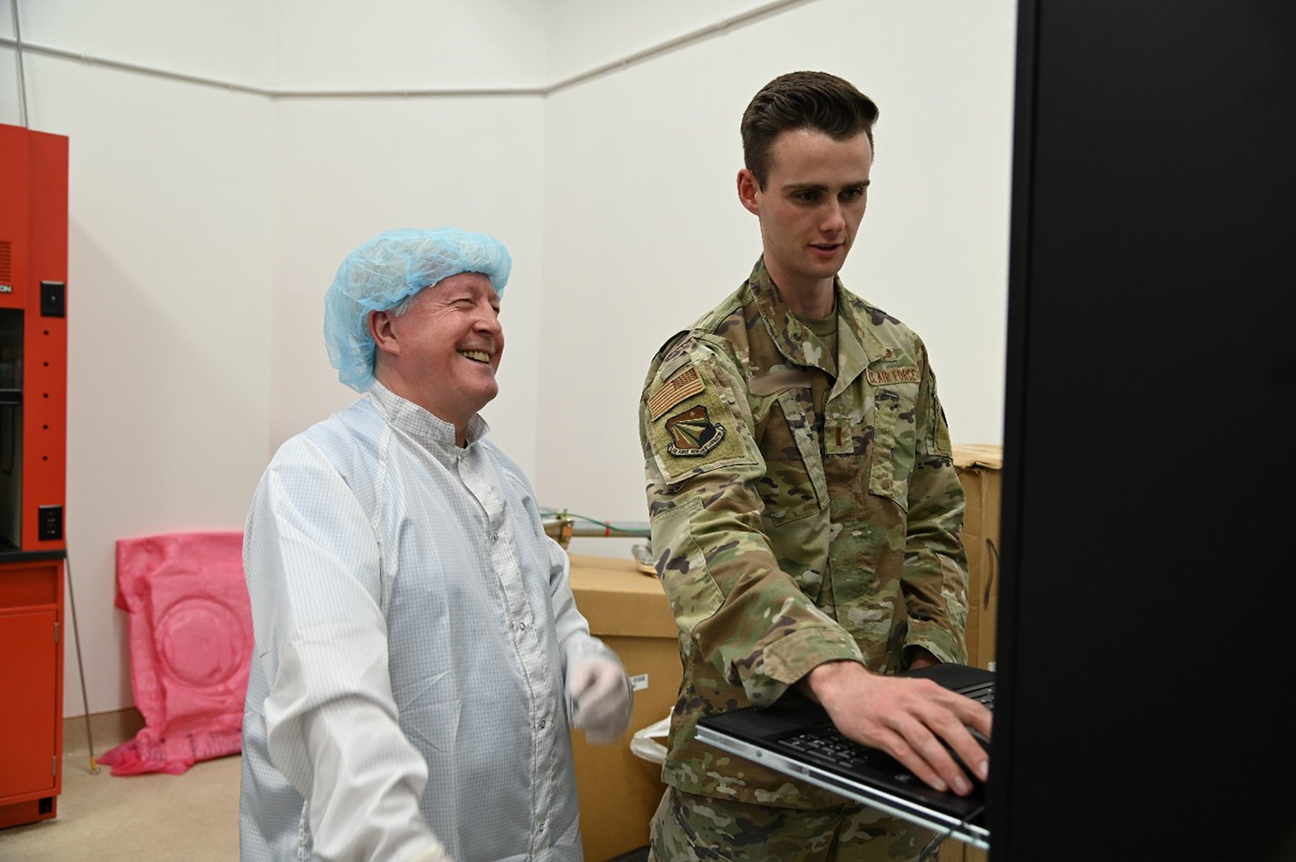New diagnostic system to validate high-power laser weapon performance
KIRTLAND AIR FORCE BASE, N.M. (AFRL) — The Air Force Research Laboratory, or AFRL’s, Directed Energy Directorate, completed the build of its new Government Radiometrically-Accurate Instrument for Laser Evaluation Version II, or GRAILE-II, system Jan. 18, 2024. The diagnostic system will be used to validate the performance of the Department of Defense, or DOD’s, most powerful high-energy laser systems.

From left: Dominick Fasulo, BAE facilities specialist; Chuck Dahl, BAE electrical engineer; Debashis Satpathi, Government Radiometrically-Accurate Instrument for Laser Evaluation Version II, or GRAILE-II, program manager; and Ian Lee, GRAILE-II technical lead at BAE Systems, before transporting GRAILE-II to the Air Force Research Laboratory for system acceptance, Feb. 27, 2024. The GRAILE-II diagnostic system will be used to validate the performance of the Department of Defense’s most powerful high-energy laser systems. (Courtesy photo / Gina Schreiner)
According to Dr. Joseph Cox, GRAILE-II technical lead at the Directed Energy Directorate, AFRL can use GRAILE-II to evaluate the performance of industry-developed laser-based weapon systems to ensure they meet the government’ and services’ specifications. These tools ensure the government and taxpayers receive the expected capabilities when an industry partner delivers a laser system.
“This is for government evaluation of the laser device itself before it is weaponized by integration with other laser weapon system components such as a beam director,” said Dr. Larry McKee, GRAILE-II Program Executive Officer, Simulation, Training and Instrumentation or PEO STRI, subject matter expert.

Carson McLaughlin, Air Force Research Laboratory, or AFRL, Directed Energy Directorate research physicist, validates the Government Radiometrically-Accurate Instrument for Laser Evaluation Version II, or GRAILE-II’s optical alignment in preparation for acceptance testing at AFRL’s Directed Energy Directorate at Kirtland Air Force Base N.M., Feb. 27, 2024. The GRAILE-II diagnostic system will be used to validate the performance of the Department of Defense’s most powerful high-energy laser systems. (Courtesy photo / Jason Lu)
McKee added there are many factors besides the laser itself that can help get a beam on a target. GRAILE-II will be primarily utilized for the part of the laser system that produces the laser’s energy.
“What is really important here is to have a government-owned and operated diagnostic system that can validate the performance of a high energy laser system developed by contractors,” said McKee. “[There was] a serious concern about having the diagnostic capability to test 300 to 500 kilowatt lasers with an independent government diagnostic.”
GRAILE-II is the result of collaborative efforts between the AFRL Directed Energy Directorate; Under Secretary of Defense for Research and Engineering, or OUSD (R&E); Test Resource Management Center; Army PEO STRI; and BAE Systems Space and Mission Systems, Inc. (formerly Ball Aerospace) and will be used to evaluate laser-based weapons systems throughout the country that the DOD is interested in, according to Ian Lee, GRAILE-II technical lead at BAE Systems.

Ian Lee, BAE Systems Government Radiometrically-Accurate Instrument for Laser Evaluation Version II, or GRAILE-II technical lead opens the GRAILE-II enclosure in preparation for system cleaning and alignment Feb. 27, 2024, at at AFRL’s Directed Energy Directorate at Kirtland Air Force Base N.M. The GRAILE-II diagnostic system will be used to validate the performance of the Department of Defense’s most powerful high-energy laser systems. (Courtesy photo / Jason Lu)
“For over 14 years now, the DOD has been investing in high-power, electrically driven lasers and concurrently, diagnostics so we can ensure those systems, built [principally] by the industrial base, meet rigorous government standards,” said Dr. Nicholas Morley, a senior scientist based in AFRL’s Directed Energy Directorate. “[It is] not just their power, but their performance ability in beam focus, as well as other technical qualities such as polarization, wavelength stability, etc.”
According to Morley, GRAILE-II has the highest power capacity of any laser diagnostic system currently available in the inventory. The system will be used to evaluate laser sources being developed under DOD funding with power in excess of 500 kilowatts, enabling it to handle the highest power of any available diagnostic.
“The OUSD (R&E) sponsored High Energy Laser Scaling Initiative, also known as HELSI, is pushing the state of the art in laser weapon system power and performance, and with GRAILE-II [AFRL is] pushing the state of the art on the diagnostics to qualify those laser weapon systems,” said Morley.
GRAILE-II follows a progression of diagnostic systems that has been ongoing since the mid-2000s as laser-based weapon systems have become more powerful and better evaluation tools are needed, according to Morley. This system will replace GRAILE-I, which is able to test laser systems that generate up to 300 kilowatts of power, itself a 200% increase in power from its predecessors.

Ian Lee, BAE Systems Government Radiometrically-Accurate Instrument for Laser Evaluation Version II, or GRAILE-II technical lead at BAE Systems and 2nd Lt. Carson McLaughlin Air Force Research Laboratory, or AFRL, Directed Energy Directorate research physicist, validate GRAILE-II’s functionality using the computer interface Feb. 27, 2024, at AFRL’s Directed Energy Directorate at Kirtland Air Force Base N.M. GRAILE-II is the result of collaborative efforts between the AFRL’s Directed Energy Directorate; Under Secretary of Defense for Research and Engineering; Test Resource Management Center; Army Program Executive Officer Simulation, Training and Instrumentation; and BAE Systems Space and Mission Systems, Inc. (Courtesy photo / Jason Lu)
“GRAILE-II is a follow-on to a successful GRAILE-I effort that is currently being used for this role,” said Lee. “We worked with other groups developing diagnostic systems, leveraging lessons learned from the first units for characterizing high energy laser systems.”
Another feature of GRAILE-II is ease of use. According to Lee, one of the goals of the system’s design is to be transportable and easy to set up and use.
“If someone wants to test with our laser diagnostic, they pay for shipping, and a couple of people go out there, spend a day aligning the delivered system and it’s ready to test,” said Cox. “It’s a lot simpler, lower cost and more efficient to do testing this way versus how past designs have done it.”
About AFRL
The Air Force Research Laboratory is the primary scientific research and development center for the Department of the Air Force. AFRL plays an integral role in leading the discovery, development, and integration of affordable warfighting technologies for our air, space and cyberspace force. With a workforce of more than 12,500 across nine technology areas and 40 other operations across the globe, AFRL provides a diverse portfolio of science and technology ranging from fundamental to advanced research and technology development. For more information, visit: www.afresearchlab.com.
